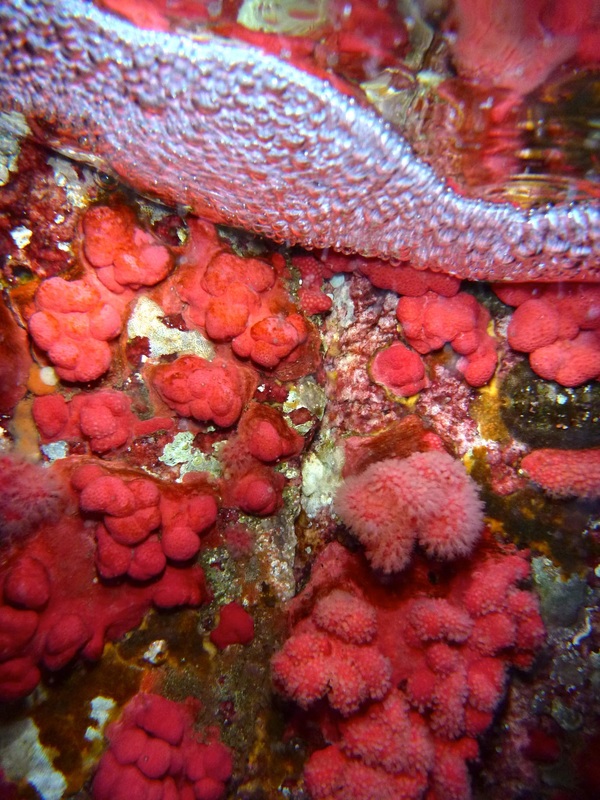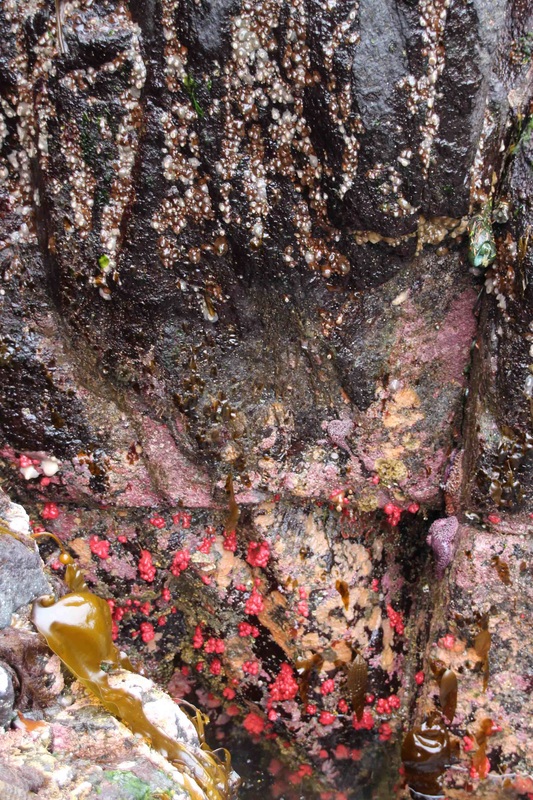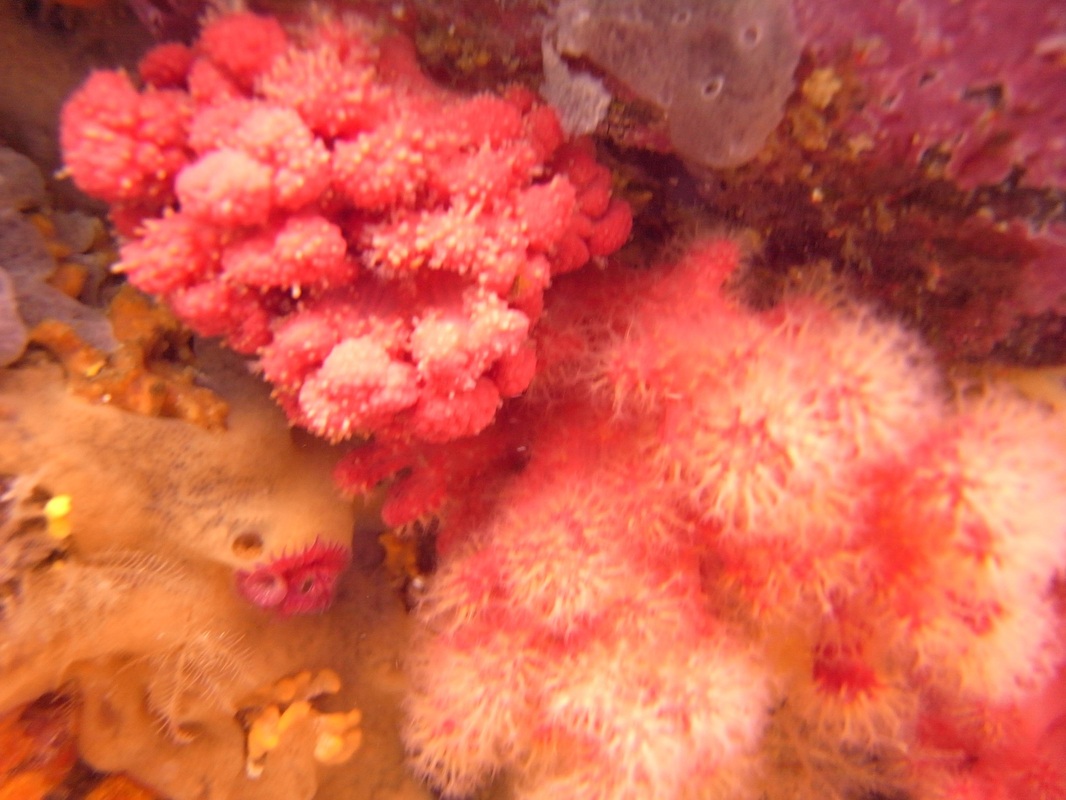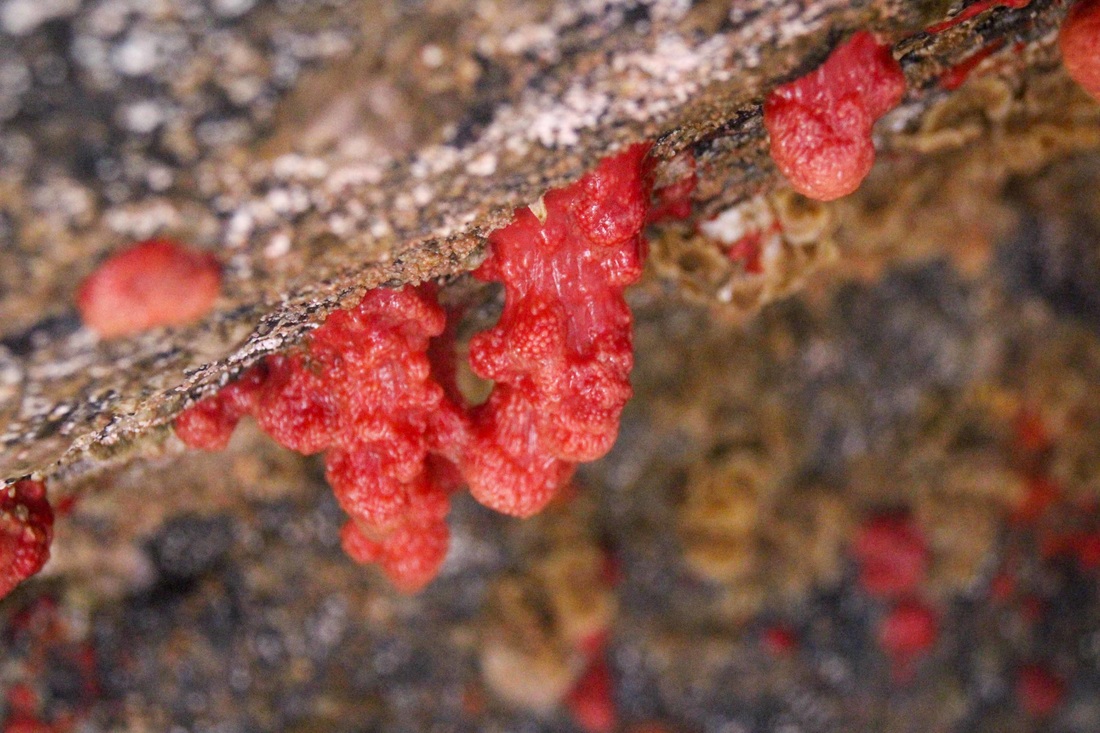Red soft coral • Gersemia rubiformis, Eunephthya rubiformis
|
Red soft coral at various stages of expansion and contraction. Photos by Angeleen Olson (top left), Jenn Burt (top right), and Sara Wickham (bottom).
|
Identification
This colonial soft coral is also known as the sea strawberry. It has thick, soft, red-pink lobes, and individual polyps within the colony have eight tentacles. This species appears quite plump and fluffy when inflated, however when the colony is disturbed, it contracts to become much smaller, shrunken, and brain-like. Colonies can reach heights of 30 cm, and lengths between 5 cm and 15 cm.
Habitat and Range
This species has widespread distribution in both the northern Atlantic and Pacific Oceans, and can be found in the intertidal and subtidal to depths of 36 m or more; reports of its depth limit vary, from 20 m or more, to at least 36 m, to more than 200 m, and it may even be found as deep as 2000 m. Colonies typically grow on rocks or on fragments of shells in high-current areas. Its eastern Pacific range extends from the Bering Sea to California.
Intriguing Information
Large aggregations of this species are often referred to as Strawberry Grounds, and are recognized by fishermen as good areas for harvesting lobster. Scientists also recognize these Strawberry Grounds as important habitats not only for lobsters, but for other benthic species as well. Juvenile basket stars (Gorgonocephalus eucnemis) are closely associated with red soft coral, and are often found nestled in the pharynges of red soft coral polyps, where they feed and grow.
This colonial soft coral is also known as the sea strawberry. It has thick, soft, red-pink lobes, and individual polyps within the colony have eight tentacles. This species appears quite plump and fluffy when inflated, however when the colony is disturbed, it contracts to become much smaller, shrunken, and brain-like. Colonies can reach heights of 30 cm, and lengths between 5 cm and 15 cm.
Habitat and Range
This species has widespread distribution in both the northern Atlantic and Pacific Oceans, and can be found in the intertidal and subtidal to depths of 36 m or more; reports of its depth limit vary, from 20 m or more, to at least 36 m, to more than 200 m, and it may even be found as deep as 2000 m. Colonies typically grow on rocks or on fragments of shells in high-current areas. Its eastern Pacific range extends from the Bering Sea to California.
Intriguing Information
Large aggregations of this species are often referred to as Strawberry Grounds, and are recognized by fishermen as good areas for harvesting lobster. Scientists also recognize these Strawberry Grounds as important habitats not only for lobsters, but for other benthic species as well. Juvenile basket stars (Gorgonocephalus eucnemis) are closely associated with red soft coral, and are often found nestled in the pharynges of red soft coral polyps, where they feed and grow.
References
Buzeta, M-I. and R. Singh. 2008. Identification of Ecologically and Biologically Significant Areas in the Bay of Fundy, Gulf of Maine. Volume 1: Areas identified for review, and assessment of the Quoddy Region. Can. Tech. Rep. Fish. Aquat. Sci. 2788: vii + 80 p.
Cowles, D. (2005). Gorgonocephalus eucnemis (Muller and Troschel, 1842). Invertebrates of the Salish Sea. Rosario Beach Marine Laboratory. Accessed 2016-03-01.
Gotshall, D. W. (1994). Guide to marine invertebrates: Alaska to Baja California. Sea Challengers, Monterey, CA. 105 pp
Harbo, R. M. (1999). Whelks to whales: Coastal marine life of the Pacific Northwest. Madeira Park, BC: Harbour Publishing. P.37.
Iken, K., Bluhm, B., and Blanchard, A. (2012). Sea raspberry: Gersemia rubiformis (Ehrenberg,1834). Accessed through Arctic Ocean Diversity at https://www.arcodiv.org/seabottom/cnidaria/Gersemia_rubiformis.html#
Lamb, A., and Hanby, B. (2005). Marine Life of the Pacific Northwest [electronic version]. Madeira Park, BC: Harbour Publishing.
van Ofwegen, L. (2015). Gersemia rubiformis. Accessed through: World Register of Marine Species at https://marinespecies.org/aphia.php?p=taxdetails&id=156103 on 2016-03-02
Williams, G. C., and L. Lundsten. "The nephtheid soft coral genus Gersemia (Marenzeller, 1878) with the description of a new species from the northeast Pacific and a review of two additional species (Octocorallia: Alcyonacea)."Zoologische Mededelingen, Leiden 83.34 (2009): 1067-1081.
Authors and editors of page
Bea Proudfoot and Kelly Fretwell (2016)
Buzeta, M-I. and R. Singh. 2008. Identification of Ecologically and Biologically Significant Areas in the Bay of Fundy, Gulf of Maine. Volume 1: Areas identified for review, and assessment of the Quoddy Region. Can. Tech. Rep. Fish. Aquat. Sci. 2788: vii + 80 p.
Cowles, D. (2005). Gorgonocephalus eucnemis (Muller and Troschel, 1842). Invertebrates of the Salish Sea. Rosario Beach Marine Laboratory. Accessed 2016-03-01.
Gotshall, D. W. (1994). Guide to marine invertebrates: Alaska to Baja California. Sea Challengers, Monterey, CA. 105 pp
Harbo, R. M. (1999). Whelks to whales: Coastal marine life of the Pacific Northwest. Madeira Park, BC: Harbour Publishing. P.37.
Iken, K., Bluhm, B., and Blanchard, A. (2012). Sea raspberry: Gersemia rubiformis (Ehrenberg,1834). Accessed through Arctic Ocean Diversity at https://www.arcodiv.org/seabottom/cnidaria/Gersemia_rubiformis.html#
Lamb, A., and Hanby, B. (2005). Marine Life of the Pacific Northwest [electronic version]. Madeira Park, BC: Harbour Publishing.
van Ofwegen, L. (2015). Gersemia rubiformis. Accessed through: World Register of Marine Species at https://marinespecies.org/aphia.php?p=taxdetails&id=156103 on 2016-03-02
Williams, G. C., and L. Lundsten. "The nephtheid soft coral genus Gersemia (Marenzeller, 1878) with the description of a new species from the northeast Pacific and a review of two additional species (Octocorallia: Alcyonacea)."Zoologische Mededelingen, Leiden 83.34 (2009): 1067-1081.
Authors and editors of page
Bea Proudfoot and Kelly Fretwell (2016)







